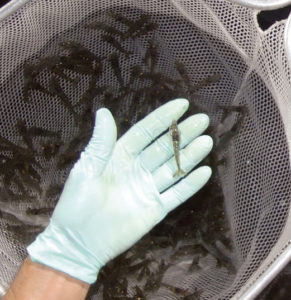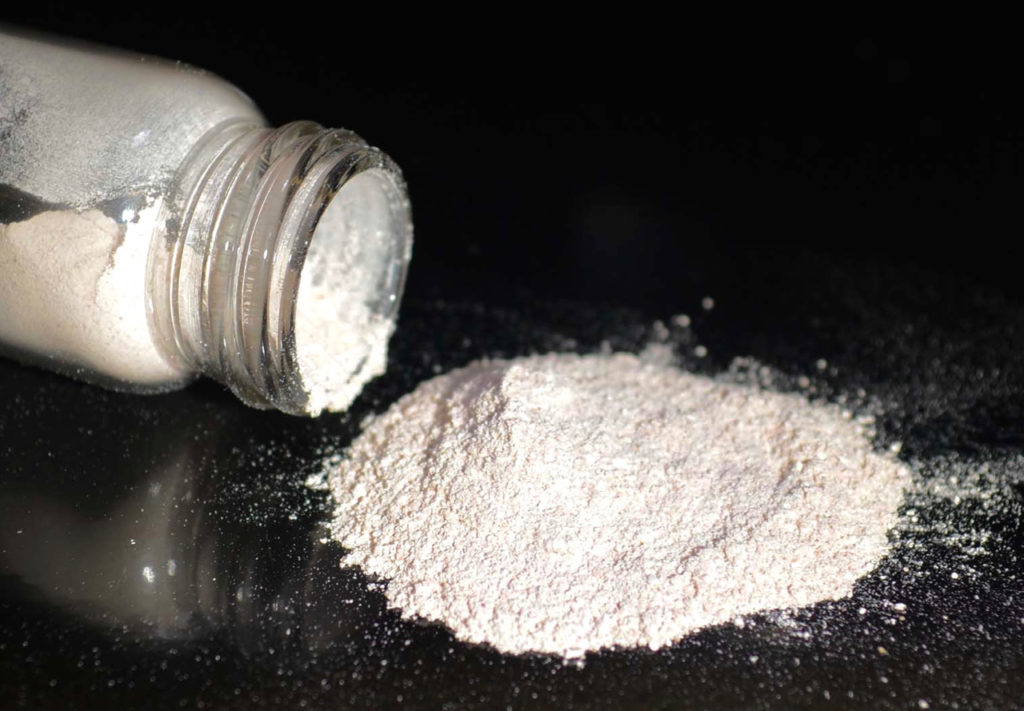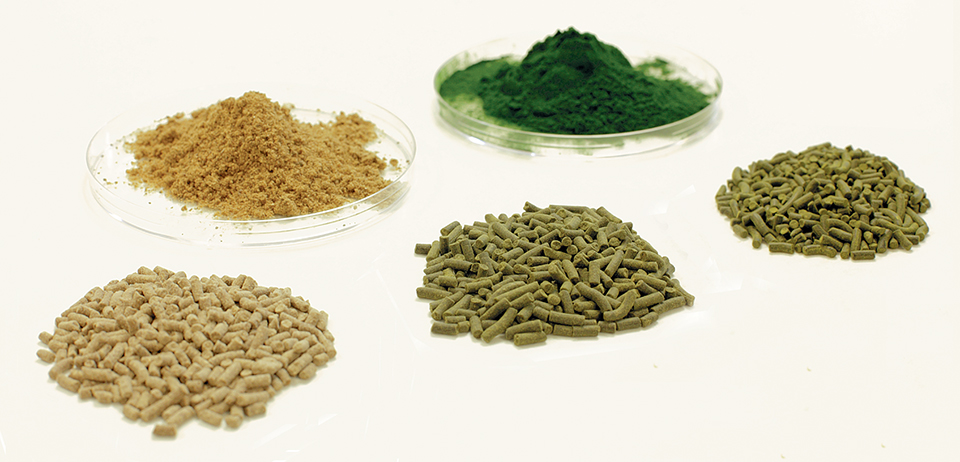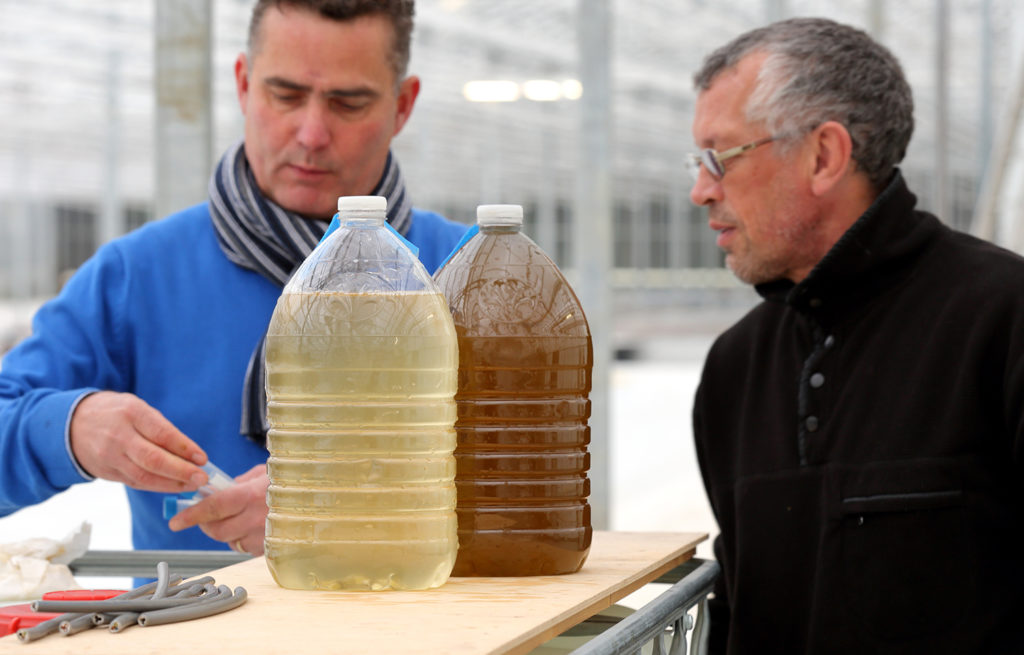Storage conditions change fishmeal composition, not shrimp growth

Fishmeal is an important dietary ingredient for aquatic diets due to its ideal amino acid profile for most cultured species, excellent palatability and the availability of polyunsaturated fatty acids and minerals. The quality of fishmeal, however, can be affected by different factors.
Many studies have shown the quality of fishmeal is affected by raw material freshness as well as the species of fish and processing conditions used to manufacture the fishmeal. Different responses to the quality of fishmeal have also been attributed to the species being tested and their size or life history stage.
Furthermore, management of the finished meals is critical for the quality of fishmeal, which is susceptible to oxidation. Both rancidity from lipid oxidation and the presence of biogenic amines produced from protein oxidation affect fishmeal quality.
Responses and sensitivity to the effects of oxidized fishmeal are different for different species of fish and shrimp. For example, cadaverine and putrescine act as chemoattractants for freshwater prawns at 2,000 mg/kg in diets. Putrescine was found to adversely affect both feed intake and growth of rainbow trout at a concentration of 13,300 mg/kg diet. Therefore, evaluation using a growth trial is necessary to evaluate the quality of a fishmeal in addition to data representing the degree of oxidation based on chemical analysis.
Pink salmon
Pink salmon is one of the major harvested species in commercial fisheries in Alaska, USA. The total harvest for 2011 was about 115 million fish weighing about 180,000 metric tons. The processing of this fish generates significant waste reflecting 25 to 30 percent of the whole fish, which is available for the production of fishmeal. A 2009 study by Ted Wu and fellow researchers found that delayed handling of raw pink salmon processing by-products impaired the quality of fishmeal based on chemical analysis related to lipid and protein oxidation.
In the authors’ study, the objective was to investigate the effects of storage temperature and duration on the quality of finished fishmeal based on the growth performance of juvenile shrimp. The study was funded by a grant from the U.S. Department of Agriculture Agricultural Research Service and through a cooperative agreement with the University of Alaska Fairbanks.
Growth trial
Pink salmon meal from the Kodiak Fishmeal Co. in Alaska was processed by the standard Atlas-Stord wet reduction technology. The fishmeal was divided into equal proportions and sealed in different bags protected from light under the conditions shown in Table 1.
Fang-Deng, Conditions for fishmeal, Table 1
| FM6-CT | FM12-CT | FM6-AT | FM12-AT | FM-C |
|---|
FM6-CT | FM12-CT | FM6-AT | FM12-AT | FM-C |
|---|---|---|---|---|
| 6 months @ 4° C | 12 months @ 4° C | 6 months @ 30° C | 12 months @ 30° C | 12 months @ -80° C |
Six test diets were formulated as 36.8 percent whole wheat, 25.0 percent soybean meal, 15.0 percent fishmeal, 6.0 percent squid meal and 17.8 percent other products, including minerals, vitamins and oil. All tests diets had similar 32 percent protein and 9 percent lipid contents. The diets were agglomerated by a pellet mill into 2.4- x 4.0-mm pellets.
The growth trial was conducted in an indoor flow-through saltwater system with a photoperiod of 12 hours light and 12 hours dark. Specific pathogen-free shrimp were randomly stocked into 20 tanks at a density of 20 shrimp/tank (83 shrimp/m2). The shrimp were fed daily at 8 to 15 percent of body weight using automatic feeders. The feed for each tank was loaded into the feeder at 8:30 a.m. daily. Shrimp were weighed every two weeks, and the feeding rate was adjusted based on growth rate.
During the trial, water quality was monitored, with temperature at 26.5 ± 0.1 degrees-C; dissolved-oxygen concentrations at 6.6 ± 0.2 mg/L, salinity at 30.7 ± 0.1 ppt and pH at 7.6 ± 0.2. Total ammonia-nitrogen levels were below 0.05 ± 0.01 mg/L. At the end of a six-week feeding trial, shrimp from each tank were killed with ice. The tail muscles from shrimp in each tank were pooled, freeze dried and then stored at -80 degrees C until analyzed.
All data were subjected to one-way analysis of variance. Treatment means were considered significantly different at the level of P < 0.05.
Results
The proximate compositions of the salmon meals stored at different conditions were similar except that the two meals stored at 4 degrees-C showed increased moisture levels and thus had lower levels of dry matter (Table 2). This was likely due to absorption of moisture in the fishmeal during the storage period.
Fang-Deng, Proximate and amino acid compositions, Table 2
| Analysis | FM6-CT | FM12-CT | FM6-AT | FM12-AT | FM-C |
|---|
Analysis | FM6-CT | FM12-CT | FM6-AT | FM12-AT | FM-C |
|---|---|---|---|---|---|
| Proximate Composition (%) | |||||
| Ash | 87.60 | 87.00 | 96.30 | 96.20 | 91.90 |
| Dry matter | 12.90 | 11.90 | 13.80 | 13.10 | 12.60 |
| Crude protein | 59.50 | 60.80 | 61.70 | 61.30 | 60.60 |
| Crude lipid | 9.40 | 9.40 | 9.80 | 9.10 | 9.50 |
| Non-Essential Amino Acids (%) | |||||
| Alanine | 4.65 | 4.51 | 4.50 | 4.42 | 4.69 |
| Aspartate + asparagine | 3.84 | 3.62 | 3.82 | 3.53 | 4.30 |
| Glutamate + glutamine | 4.42 | 4.66 | 5.03 | 5.07 | 5.15 |
| Glycine | 7.26 | 7.24 | 6.75 | 6.54 | 7.35 |
| Proline | 3.05 | 3.25 | 3.06 | 3.06 | 3.15 |
| Serine | 2.19 | 2.21 | 2.08 | 2.09 | 2.36 |
| Tyrosine | 1.83 | 1.69 | 1.47 | 1.58 | 1.56 |
| Essential Amino Acids (%) | |||||
| Arginine | 5.37 | 5.26 | 5.24 | 5.16 | 5.56 |
| Histidine | 2.68 | 2.48 | 2.61 | 2.61 | 2.71 |
| Isoleucine | 2.72 | 2.70 | 2.49 | 2.50 | 2.71 |
| Leucine | 3.14 | 3.12 | 2.69 | 2.95 | 3.15 |
| Lysine | 3.69 | 3.70 | 2.98 | 3.01 | 3.71 |
| Methionine | 1.45 | 1.44 | 1.46 | 1.34 | 1.49 |
| Phenylalanine | 1.87 | 1.88 | 1.25 | 1.12 | 1.80 |
| Threonine | 2.75 | 2.59 | 2.71 | 2.62 | 2.82 |
| Valine | 4.75 | 4.29 | 3.87 | 3.99 | 4.23 |
| Subtotal of Non-Essential Amino Acids (%) | 27.24 | 27.18 | 26.73 | 26.30 | 28.56 |
| Subtotal of Essential Amino Acids (%) | 28.42 | 27.45 | 25.30 | 25.30 | 28.17 |
| Total | 55.66 | 54.64 | 52.03 | 51.60 | 56.73 |
The overall levels of amino acids were lower for the salmon meal stored at 30 degrees-C than those of fishmeal preserved at 4 or minus-80 degrees-C. This indicated degradation or oxidation of amino acids in the fishmeal stored under high temperature. The proximate compositions were very similar among different test diets (Table 3).
Fang-Deng, Nutrient compositions, Table 3
| Nutrient | FM6-CT | FM12-CT | FM6-AT | FM12-AT | FM-C |
|---|
Nutrient | FM6-CT | FM12-CT | FM6-AT | FM12-AT | FM-C |
|---|---|---|---|---|---|
| Dry matter | 92.9 | 93.4 | 93.3 | 93.5 | 93.4 |
| Ash | 12.9 | 13.0 | 13.0 | 12.9 | 23.0 |
| Protein | 31.6 | 31.8 | 32.3 | 31.1 | 31.4 |
| Lipid | 9.1 | 8.8 | 8.9 | 9.0 | 9.3 |
| Gross energy (kcal/100 g) | 410.6 | 412.4 | 41.2.6 | 413.9 | 410.9 |
Results from the growth trial showed that shrimp fed diets formulated with different fishmeal had similar growth rates, feed-conversion ratios and survival (Table 4). The overall survival of shrimp was similar among different treatments, but at 75 to 85 percent was lower that the 90 percent survival observed in previous studies by the authors using the same reference diet.
Fang-Deng, Mean growth performance, Table 4
| Parameter | FM6-CT | FM12-CT | FM6-AT | FM12-AT | FM-C |
|---|
Parameter | FM6-CT | FM12-CT | FM6-AT | FM12-AT | FM-C |
|---|---|---|---|---|---|
| Initial body weight (g) | 1.17 ± 0.02 | 1.16 ± 0.01 | 1.13 ± 0.03 | 1.17 ± 0.01 | 1.17 ± 0.03 |
| Final body weight (g) | 6.80 ± 0.20 | 6.60 ± 0.10 | 6.50 ± 0.10 | 7.20 ± 0.30 | 6.90 ± 0.20 |
| Weight gain/week (g) | 0.94 ± 0.03 | 0.91 ± 0.02 | 0.90 ± 0.02 | 1.01 ± 0.05 | 0.95 ± 0.03 |
| Specific growth rate (%) | 4.19 ± 0.05 | 4.15 ± 0.06 | 4.17 ± 0.03 | 4.33 ± 0.11 | 4.22 ± 0.05 |
| Feed-conversion ratio | 2.08 ± 0.03 | 2.10 ± 0.05 | 2.08 ± 0.04 | 2.01 ± 0.07 | 2.05 ± 0.03 |
| Survival (%) | 81.30 ± 3.20 | 85.00 ± 6.10 | 82.50 ± 4.30 | 75.00 ± 7.10 | 85.00 ± 2.00 |
| Dry matter (%) | 23.30 ± 0.20 | 23.10 ± 0.30 | 22.80 ± 0.20 | 23.10 ± 0.30 | 22.90 ± 0.20 |
| Ash (%) | 1.45 ± 0.05 | 1.30 ± 0.06 | 1.32 ± 0.03 | 1.36 ± 0.03 | 1.31 ± 0.03 |
| Protein (%) | 20.30 ± 0.10 | 19.90 ± 0.30 | 19.40 ± 0.40 | 20.00 ± 0.40 | 19.80 ± 0.70 |
| Lipid (%) | 0.98 ± 0.02 | 0.97 ± 0.04 | 0.92 ± 0.05 | 0.96 ± 0.02 | 0.93 ± 0.05 |
| Gross energy (cal/g) | 114.60 ± 1.10 | 111.90 ± 2.10 | 108.50 ± 0.90 | 113.30 ± 2.60 | 109.90 ± 2.40 |
The reason may be the higher stocking density used in this trial. The quality of shrimp from a different family used in different studies may have also contributed to the different observation. The nutritional composition of shrimp tail muscle was similar among the different dietary treatments.
Perspectives
Results of this study suggested that salmon meal stored for up to 12 months at 30 degrees-C tended to show protein degradation. The study did not find any significant effect of the different types of fishmeal on growth performance, feed utilization or the nutritional composition of shrimp muscle. Therefore, the quality of shrimp feed was not downgraded when 15 percent of the fishmeal was included in a diet under current testing conditions.
However, the observation might have been different if a higher level of the aged fishmeal was tested in the diet and also if it was tested with shrimp of different sizes. A further study with a longer feeding trial will be needed for a more complete evaluation of the nutritional quality of aged fishmeal.
(Editor’s Note: This article was originally published in the November/December 2012 print edition of the Global Aquaculture Advocate.)
Now that you've reached the end of the article ...
… please consider supporting GSA’s mission to advance responsible seafood practices through education, advocacy and third-party assurances. The Advocate aims to document the evolution of responsible seafood practices and share the expansive knowledge of our vast network of contributors.
By becoming a Global Seafood Alliance member, you’re ensuring that all of the pre-competitive work we do through member benefits, resources and events can continue. Individual membership costs just $50 a year.
Not a GSA member? Join us.
Authors
-
Dong-Fang Deng, Ph.D.
Aquatic Feeds and Nutrition Department
Oceanic Institute
41-202 Kalaniana’ole Highway
Waimanalo, Hawaii 96795 USA -
Zhi Yong Ju, Ph.D.
Aquatic Feeds and Nutrition Department
Oceanic Institute
41-202 Kalaniana’ole Highway
Waimanalo, Hawaii 96795 USA -
Lytha D. Conquest
Warren G. Dominy, Ph.D.
Aquatic Feeds and Nutrition Department
Oceanic Institute
41-202 Kalaniana’ole Highway
Waimanalo, Hawaii 96795 USA -
Peter J. Bechtel, Ph.D.
United States Department of Agriculture
Agricultural Research Service
Subarctic Agricultural Research Unit
Fishery Industrial Technology Center
Kodiak, Alaska, USA -
Scott Smiley, Ph.D.
Fishery Industrial Technology Center
School of Fisheries & Ocean Sciences
University of Alaska
Kodiak, Alaska, USA
Tagged With
Related Posts

Aquafeeds
A look at protease enzymes in crustacean nutrition
Food digestion involves digestive enzymes to break down polymeric macromolecules and facilitate nutrient absorption. Enzyme supplementation in aquafeeds is a major alternative to improve feed quality and nutrient digestibility, gut health, compensate digestive enzymes when needed, and may also improve immune responses.

Aquafeeds
A new nutrient for aquaculture, from microbes that consume carbon waste
Biotechnology firm NovoNutrients aims to produce a line of nutraceutical aquafeed additives as well as a bulk feed ingredient that can supplement fishmeal. Its process includes feeding carbon dioxide from industrial gas to a “microbial consortium” starring hydrogen-oxidizing bacteria.

Aquafeeds
Algae alternative: Chlorella studied as protein source in tilapia feeds
Chlorella and other species have potential as protein sources in aquafeeds. In trials with tilapia fry raised in a recirculating system, the fish received a fishmeal-based control diet or feeds with portions of the fishmeal replaced by Chlorella.

Innovation & Investment
Algae innovators aim to freeze out early-stage shrimp losses
A greenhouse in Belgium believes its innovative shrimp feed product, made from freeze-dried microalgae, packs the necessary nutrients for the crustacean’s most vulnerable life stage: the first three days of its life.



